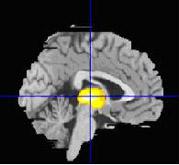
Athletes' cerebral gray matter concentration in bilateral thalamus drastically higher than average people.
During the Olympic Games just held in Beijing this summer, athletes like Usain Bolt and Michael Phelps shocked the world with their unbelievable performance. Upon amazement, we cannot help wonder: does the professional training affect the athletes' brain in addition to their muscles and hearts?
Using Nuclear Magnetic Resonance Technology, Wei Gaoxia, Ph.D and Luo Jing, Ph.D from the Institute of Psychology, CAS recently conducted a research on the brain structure of 12 Chinese top Diving athletes for the first time. Compared with 12 students who match exactly with the athletes in gender, age, weight and other demographic factors, these athletes' cerebral gray matter density in bilateral thalamus and left frontal lobe (BA6) is dramatically higher.
According to previous research, patients affected by Huntington's disease and Parkinson's disease have a lower than normal cerebral gray matter density. The research conducted by Wei and Luo approved from a different approach the correlation between cerebral gray matter density in bilateral thalamus and human movement behavior. The research also suggests that rehabilitation training focusing on movements and skills could effectively increase human brain's cerebral gray matter density in bilateral thalamus.
In addition to providing new insights in treating dyskinesia and rebuilding body movement ability, this finding corrects the delusion that athletes have simple mind. As a matter of fact, in giving them more athletic ability, training makes their brain more complex. The research also supports the hypothesis that long professional experience could trigger plastic changes in related brain regions. Practice makes perfect may be scientifically true.
Related News
Photos
More>>trade
market
finance
- Think Twice before Publicizing, Advocating and Promoting the Production of Stone
- Promoting Rapeseeds Industry Development by Transforming Mode of Development
- The 10th China Patent and High-Tech Products Expo Opened in Jining, Shandong
- "Rail Electric Traction Engineering Forum Held in Zhuzhou
- CAE President Zhou Ji Attended Serial Events Dedicated to Combining Efforts of





